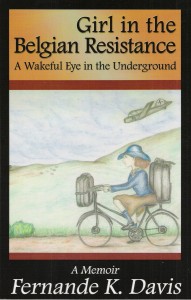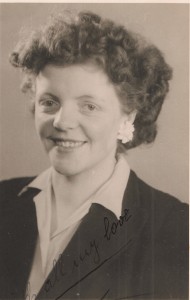The memory of the cruelty and violence by the Germans during the first World War triggered strong feelings of hate and anger in the Belgium population. Most of all however, it was fear that dictated all decisions and behavior. Home for the Keufgens family was in Montzen, located a few miles from the border with Germany. I was sixteen and a half years old, living with my father’s friends in Andenne, the idea being that, if there was a German invasion, I would be protected from an eventual draft. Hitler was always looking to use young people in the invaded countries, to be sent to the ammunition factories in Germany. Father was hoping that our Belgian army would get help from England and stop the German advances.
On May 10, 1940, we awoke to the noise of a squadron of planes passing over the town. At first, we thought that these were our Air Force pilots in practice for what we expected soon to be the second war with Germany. People ran out in the street and stared at the sky where the swastikas on the planes confirmed that we were, indeed, at war. The bombs came raining down. Instant panic arose! People screaming, “Les sales boches sont ici.” (The injurious term the Belgians assigned to the invading enemy).
Most citizens of Andenne saw only one option, Evacuate! Run for your lives. Run towards France. Surely our troops will stop them, was the cry. I saw no hesitation from anyone to leave all possessions behind. Madeleine and I grabbed one small leather suitcase each. These looked like they came from the “olden days.” They were sturdy and heavy and I had no idea how I would get them secured to a bicycle in such a short time. My fear was that Aachen, Germany was barely two hours away from us and their troops were bombing and shooting their way through our country.
Madeleine, my dainty sweet hostess the age of my mother, was struck with fear and looked totally incapable of maneuvering a bicycle loaded with a suitcase under these circumstances. She could not move the bike, let alone ride it up and down the hills of the surrounding Andennes. I would become guide and carrier.
We hurried to pack a few belongings. The only precious thing that I had, and took, was the lovely new blue hat, a gift from Maman for Easter. Mother was a hatmaker by profession before she was married and she loved the new headwear for her girls at Easter. With me coiffed in my lovely chapeau, skirt and hat flowing in the wind, we set out to join the thousands of evacuees on the road south toward France. How I maintained my equilibrium on this bike with two suitcases, one in front and one in the back secured with leather straps, I’ll never know! Never shall I forget the columns of refugees made up mainly of women, with children perched on top of farm wagons, sitting precariously on top of their belongings, older grandparents perched on vehicles of all kinds, holding babies, all riding haphazardly through the unknown countryside, hungry and overwhelmed by fear.
To understand the magnitude of such an exodus, one needs to have lived it. Thousands of families on foot, horse and wagons, motorcycles, elderly transported in wheelbarrows, all of the above stacked with clothes, pillows, mattresses, cooking utensils, some meager possessions strapped on–the whole massive group of humanity fleeing their own country to save their lives and that of their families.
Never did I think that someday I would be sitting here writing my memoirs of the incredible and painful part of almost three years of my life with its walk through a mine field, a face to face encounter with the dreaded Gestapo while carrying clandestine documents, and the miracle of a little boy saving my life. All this starting with a young girl fleeing on her bike under a reign of terror.

These stories and more I recount on my DVD ‘The Author Highlights Her Book ‘and in the book itself, Girl in the Belgian Resistance.
Fernande Keufgens Davis October 29, 2012
Read about Joanna Lloyd’s company who published Fernande Davis.
Comment on the story here.

